We went down the splendid Benguet Road, following
the bed of the Bued River [8] to the railway, a drop
of over 4,000 feet in thirteen miles. Strange
to say, the stream had not risen at all, a fortunate
circumstance, as one hundred and sixty bridges are
crossed in the drop, and at times a rise will wash
out not only the bridges, but all semblance of a road.
[9] At the railway we turned south over the great plain
of Pangasinan. This, in respect of roads, is the
show province of the Archipelago and deserves its
reputation, one hundred and twenty miles having been
built. Those we passed over this day would have
been called good in France even. Our passage was
of the nature of a progress, thanks to the presence
of the Governor-General. Simple bamboo arches
crossing the road greeted us everywhere, Mr. Forbes
punctiliously raising his hat under every one.
All the villages had decorated their houses; handkerchiefs,
petticoats, red table-cloths, anything and everything
had been hung out of the windows by way of flags and
banners. Across the front of the municipal building
of one village was stretched a banner with this inscription,
“
En honor de la venida del Gobernador General
y de su Comitiva” ("In honor of the arrival
of the Governor-General and of his retinue"), and then
below on the next band, “
Deseamos iener un
pozo artesiano” ("We should like to have
an Artesian well"), which led Mr. Worcester to remark
that four years before the banner would have demanded
“
independencia” (independence),
and not an Artesian well.
Even in Pangasinan, good roads must come to an end,
and ours did as we neared the Agno River. For
this blessed river is a curse to its neighborhood,
and rises in flood from a stream say seventy-five yards
wide to a rushing lake, if the expression be permitted,
half a mile and more across. Our car finally
refused to move; its wheels simply turned in situ,
so deep was the sand. There was nothing for it
but to walk to the river bank, where we were met with
many apologies. A bamboo bridge had been built
across the stream a few days before so that our cars
might cross, but yesterday’s rain had washed
it down, and would we try to cross on rafts?
We looked at the rafts, bamboo platforms built over
large bancas (canoes, double-enders cut out
of a single log), the bamboos being lashed together
with bejuco (rattan, the native substitute
for nails), and decided that no self-respecting motor
would stand such transportation, but would go to the
bottom first by overturning. So we got our stuff
aboard the rafts, were poled over, and made the rest
of the journey to Tayug, our first considerable halt,
in carromatas (the native two-wheeled, springless
cart). Fortunately the distance was short, the
carromata being an instrument of torture happily
overlooked by the Spanish Inquisition.




